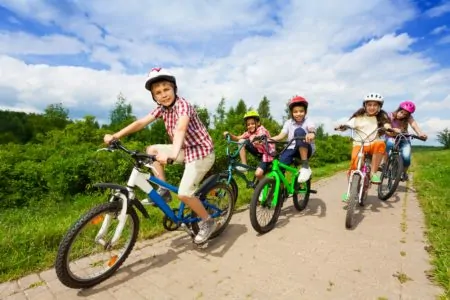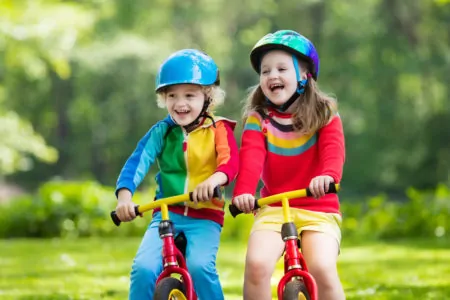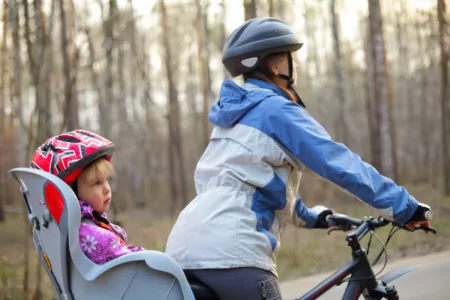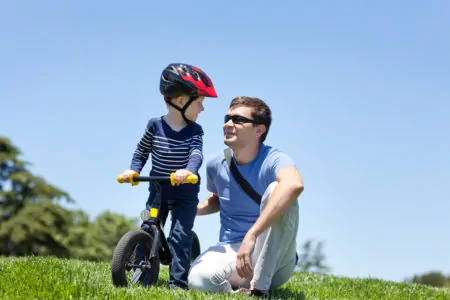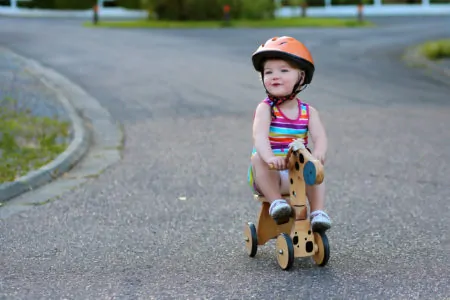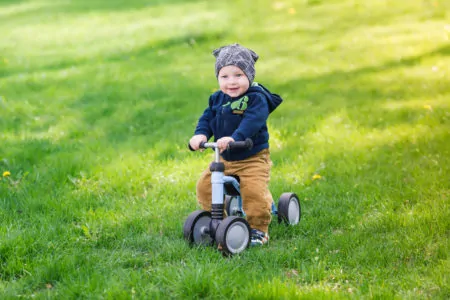When our kids were ready to ride, we learned the hard way that kids bike sizes are confusing. We made impulse buys, ended up with bikes that didn’t fit, and dealt with the frustration that followed.
A bike that is just a few inches too big can be dangerous and scary for a new rider. On the flip side, one that is too small is cramped and harder to control.
We talked to experts and broke down the math to help you avoid our mistakes. This guide cuts through the confusion so you can measure your child properly and pick the perfect bike for their safety and confidence.
Key Takeaways
- Kids bike sizes are determined by wheel diameter, not frame size like adult bikes.
- Inseam measurement is the most accurate way to size a bike; age is just a rough estimate.
- Beginners need to touch the ground with flat feet, while experienced riders only need to touch with their toes.
- Check the stepover height to ensure there is clearance between your child’s body and the top tube.
Kids Bike Size Chart
| Height | Inseam | Age | Wheel size |
| 2 feet, 9 inches to 3 feet, 1 inch | 12 to 14 inches | 2 years | 10 inches |
| 3 feet, 1 inch to 3 feet, 3 inches | 14 to 17 inches | 2 to 3 years | 12 inches |
| 3 feet, 3 inches to 3 feet, 7 inches | 16 to 20 inches | 3 to 4 years | 14 inches |
| 3 feet, 7 inches to 3 feet, 8 inches | 18 to 22 inches | 4 to 5 years | 16 inches |
| 3 feet, 8 inches to 4 feet | 20 to 24 inches | 5 to 6 years | 18 inches |
| 4 feet to 4 feet, 5 inches | 22 to 25 inches | 5 to 8 years | 20 inches |
| 4 feet, 5 inches to 4 feet, 9 inches | 24 to 28 inches | 7 to 11 years | 24 inches |
General Guide
How Kids Bike Sizes Work
Adult bikes are sized by the frame, but kids bikes are categorized by wheel diameter. Manufacturers assign a wheel size to an age range based on the average height of a child that age.
We highly recommend starting with a balance bike. These have no pedals and wheels ranging from 10 to 14 inches. They teach balance faster than training wheels.
Standard pedal bikes start at 12-inch wheels. Youth bikes go up to 24-inch or 26-inch wheels. Once you hit 26 inches, you are technically in adult bike territory, so we won’t cover those here.
Picking a wheel size is just the first step. Taller or shorter kids might need to jump up or down a size bracket regardless of their age.
The most critical factor for a beginner is being able to put their feet on the ground to stop. To figure this out, you need to know your child’s inseam.
Measuring Your Child’s Inseam
You can’t rely on pant leg size for this. To get an accurate measurement, gather these items:
- Measuring tape.
- Hardcover book.
- Pencil.
- Paper.
- Tape (optional).
- Marker.
1. Check Their Height
Have your child take off their shoes and stand flat against a wall. Measure from the floor to the top of their head. While inseam is the gold standard for bike sizing, height helps you quickly glance at manufacturer charts.
Why Height Matters
2. The Book Method
This is the most accurate way to measure inseam at home. Have your child stand against the wall with their feet slightly apart, about the width of a bike saddle. Place the hardcover book between their legs, spine up, sliding it up until it gently hits their crotch (imitating a bike seat).
3. Mark and Measure
Tell your child to step away while you hold the book firmly against the wall. Mark the top of the book on the wall with your pencil.
Measure from the floor up to that mark. This number is your child’s inseam.
4. Match Inseam to Seat Height
Look for the “minimum seat height” on the bike’s spec sheet. This is the most important number you will look at.
For a beginner, the bike’s minimum seat height should match their inseam (or be slightly lower). This allows them to plant their feet flat. If the bike is too tall, they will tip over.
If your child fits two different wheel sizes, go with the larger wheels as long as the seat goes low enough. Larger wheels roll over bumps easier and are generally more stable.
5. Consider the Wheelbase
The wheelbase is the distance between the center of the front wheel and the center of the back wheel.
Long Wheelbase: These provide a lower center of gravity. They are stable and great for beginners or kids riding fast in straight lines. It usually puts the rider in a slightly forward-leaning position.
Short Wheelbase: These make the bike more twitchy and responsive. They are good for tricks or slow-speed maneuvering, but verify your child’s knees don’t hit the handlebars when turning.
Finding the Right Fit by Bike Type
1. Balance Bikes
Balance bikes focus on steering and gliding without pedals (1). Since the child propels the bike by running, the fit needs to be perfect.
Look for a minimum saddle height that is 1 to 1.5 inches shorter than your child’s inseam.
When they sit on the saddle, their feet must be flat on the ground with a slight bend in the knee. This gives them the leverage they need to push off and run.
2. First Pedal Bike (With Training Wheels)
Sizing for training wheels is different because the bike holds itself up.
Look for a saddle height that is 1 to 3 inches higher than your child’s inseam. Since they don’t need to balance the bike, they only need to reach the pedals at the bottom of the stroke.
If your child is timid, keep the seat closer to their inseam height so they can still touch the ground if they get scared.
3. First Pedal Bike (No Training Wheels)
When the training wheels come off, stability disappears. You need to drop the seat.
Find a bike where the minimum seat height is equal to your child’s inseam. They should be able to sit on the saddle and place both feet flat on the ground. This allows them to “catch” themselves if they start to wobble.
Once they master starting and stopping, you can raise the seat 1 or 2 inches to maximize their pedaling power.
4. Second Pedal Bike
By the time your child needs their second bike, they are likely confident with brakes and turning. Now, you prioritize efficiency over safety nets.
Set the seat height 2 to 4 inches higher than their inseam. When seated, they should only be able to touch the ground with their tiptoes. This leg extension allows them to pedal hard without straining their knees.
Don’t Ignore Bike Weight
A heavy bike is the enemy of learning. Many cheap department store bikes are made of heavy steel and can weigh as much as 50 percent of the child’s body weight. Imagine trying to ride a bike that weighs half as much as you do!
Try to find a bike that is lightweight (often aluminum). It makes starting, stopping, and climbing hills significantly easier for little legs.
Adjustable Seat Height
Kids grow fast. A bike with a wide range of seat height adjustments will last you longer.
Always buy a bike where your child fits the lowest seat setting comfortably. This gives you several inches of upward adjustment as they grow. If you buy a bike where they already need the seat raised to the max, they will outgrow it in six months.
Stepover Height and Safety
The stepover height (or standover height) is the distance from the ground to the top tube of the bike frame.
When your child stands over the bike frame with feet flat on the floor, there must be a gap between the metal bar and their crotch. Aim for at least 1 to 2 inches of clearance (2).
This clearance prevents painful injuries if they slip off the pedals or have to jump forward off the seat during a sudden stop. If the frame is too high, a sudden stop becomes a painful collision.
